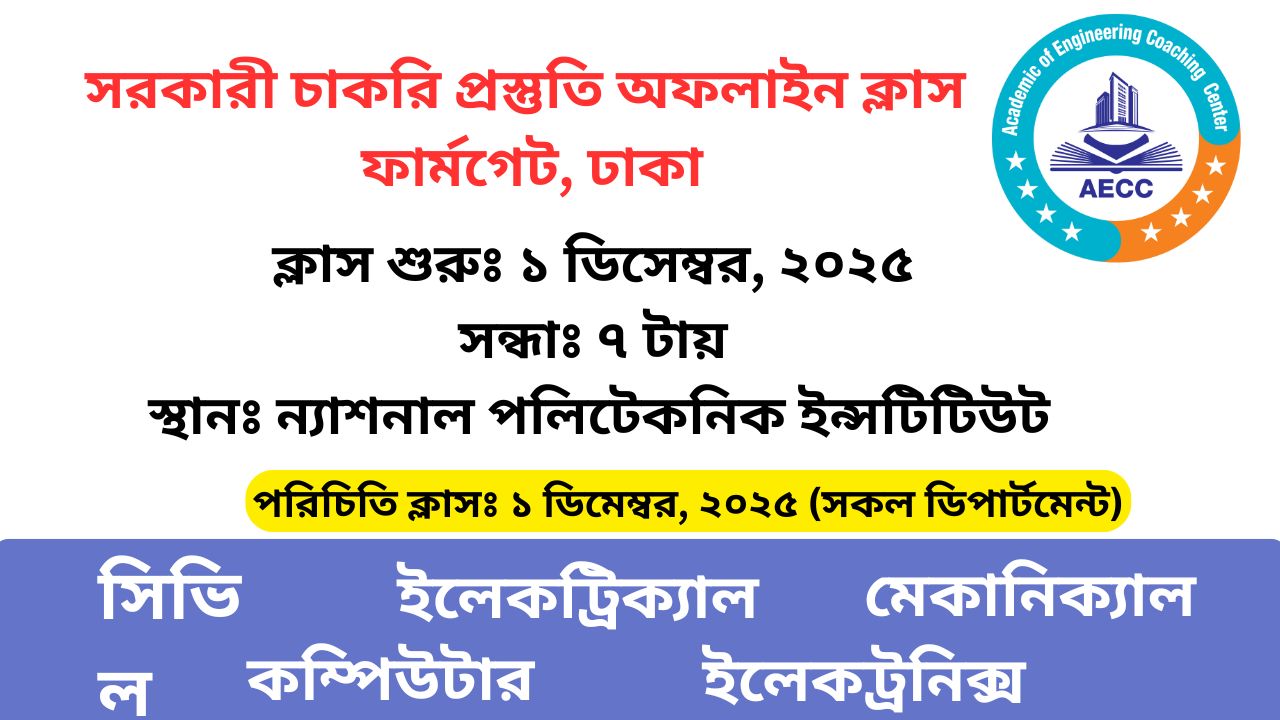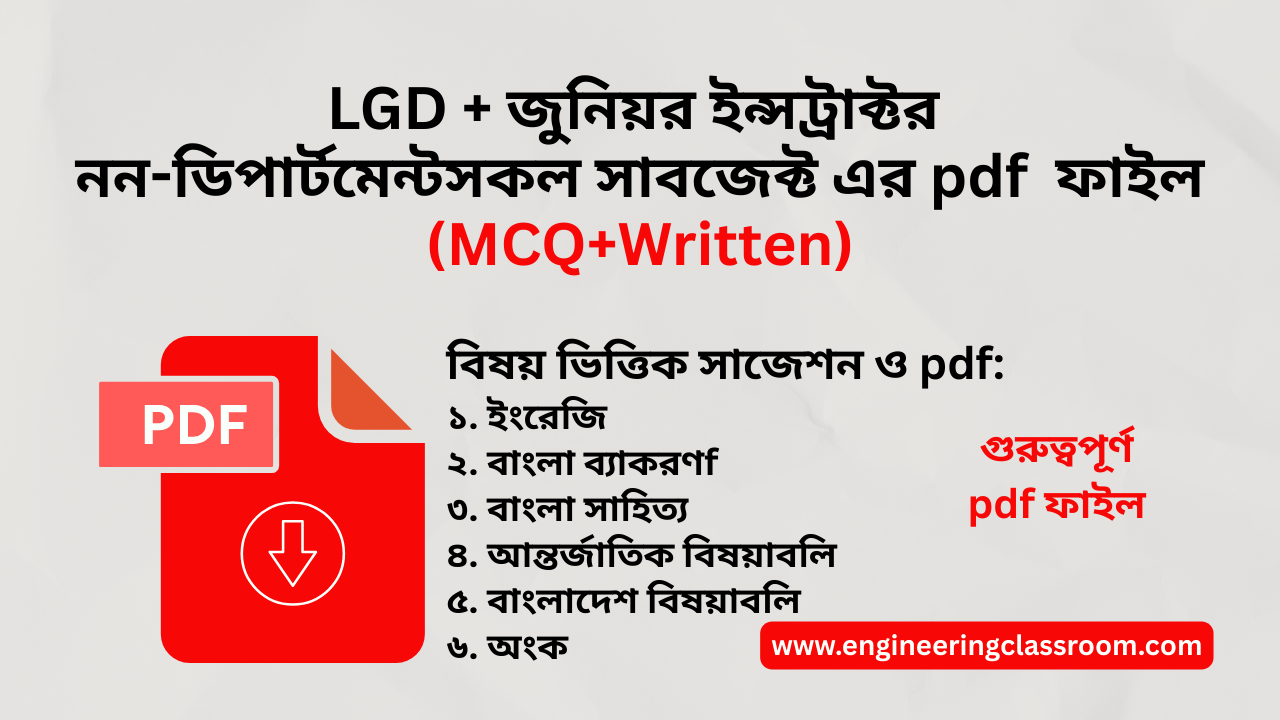MCQ
3461. এক মিমি পুরো ১০০ বর্গমিটার এমএস প্লেইন শিটের ওজন কত? [BSCIC-19, BBA-19]
৬৮৫ কেজি
৭০০ কেজি
৭৮৫ কেজি
৮৮৫ কেজি
কোনোটিই নয়
ব্যাখ্যা: ব্যাখ্যা: প্লেইন শিটের মোট আয়তন= 1×100/1000=0.1 ঘনমিটার
প্রতি ঘনমিটারে শিটের ওজন = 7850 kg
শিটের ওজন = 0.1x7850=785 kg.
3462. রিটার্ন টাইপ Wing wall অ্যাবাটমেন্টের সাথে কত ডিগ্রি কোণে থাকে?
120°
100°
90°
45°
3463. সেপটিক ট্যাঙ্কের দুই কক্ষের মাঝের ওয়ালকে বলা হয়- [SB-16]
Whope wall
বাফেল ওয়াল
Wing wall
Pier
ব্যাখ্যা: ব্যাখ্যা: সেপটিক ট্যাঙ্কের দুই কক্ষের মাঝের ওয়ালকে বাফেল ওয়াল বলে।
3464. এক বর্গমিটার জায়গা হেরিংবোন বন্ড করতে প্রয়োজনীয় ইটের সংখ্যা কত? [DM-19]
৩১টি
৫২টি
৪২টি
৬২টি
ব্যাখ্যা: ব্যাখ্যা: HBB-এ ইটের সংখ্যা = 1/(0.254 x0.076) =51.8=52টি
3465. Wing wall দৈর্ঘ্য অ্যাবাটমেন্টের উচ্চতার কত গুণ হয়?
১ থেকে ২ গুণ
২ থেকে ৩ গুণ
১.৫ থেকে ২ গুণ
৩ থেকে ৫ গুণ
3466. ১০০ ঘনফুট ইটের খোয়া প্রস্তুতিতে ইটের প্রয়োজন- [MOCA-19]
৮৫০টি
৮০০টি
৭০০টি
৭৫০টি
ব্যাখ্যা: ব্যাখ্যা: এক ঘনফুটে ইট লাগে 9টি।
100×9=900টি
3467. এক ঘনমিটার Brick Masonry কতটি ইটের প্রয়োজন? [DM-19]
৫০০টি
৪০০টি
৪৫০টি
৩৫০টি
ব্যাখ্যা: ব্যাখ্যা: ইটের প্রয়োজন (মসলাসহ)
1/(0.20×0.10 ×0.10)= 500 টি
3468. ১২"x১২" × ১২" সাইজ এর একটি বিম এর ঢালাই এর জন্য সিমেন্ট এর পরিমাণ কত? [MOCA-19]
2
3
1
none of them
ব্যাখ্যা: Wet. Volume = (12*12*12)/(12*12*12)=1 ft^3
Dry Volume 1x1.5 = 1.5ft^3
let, Ratio 1+2+4=7
Cement =( 1.5x0.8x1)/7=0.17 bag
3469. গান্টার্স শিকলের দৈর্ঘ্য-[BB-21]
33ft
44ft
55ft
66ft
3470. ইটের কাজে সাধারণত লাইম এবং বালির অনুপাতে কত ধরা হয়। [HED-19]
1:2
1:4
1:6
1:8
ব্যাখ্যা: ব্যাখ্যা: Coolime is used for brick bond replacing cement. Here use 1 part lime and 2 part sand.
3471. RCC ঢালাই করা কার্নিশ দেয়ালের গাত্র থেকে কত সেমি বাইরে থাকে? [SB-16]
৪০ থেকে ৮০cm
৫০ থেকে ৯০cm
৩০ থেকে ৬০cm
৬০ থেকে ৯০cm
ব্যাখ্যা: ব্যাখ্যা: (i) কার্নিশ দেয়ালের গাত্র থেকে 30cm- 60cm বাহিরে থাকে।
(ii) সানশেড (30cm-45cm) বাহিরে থাকে।
3472. ১:৬ অনুপাতে ১৫'-০" লম্বা, ৯'-০" চওড়া ও ১০" পুরু একটি ইটের গাঁথুনি করতে প্রতি ঘনমিটার ৩০০০.০০ টাকা হিসাবে খরচ পড়বে- [MOCA-19]
৩,০০০.০০ টাকা
১০,৫০০.০০ টাকা
৯,৪১২.০০ টাকা
৯,০০০.০০ টাকা
ব্যাখ্যা: ব্যাখ্যা: Volume = (15 x9 x 10)/ 12=112.5 ft^3=3.18m^3. 1 ঘনমিটারে খরচ পড়বে 3000 টাকা
..3.18 ঘনমিটারে খরচ পড়বে (3000×3.18)= 9,564.27 টাকা
3473. ১৪৬ অনুপাতে ১৫' × ৯' × ১০" দেওয়ালটি তৈরি করতে সিমেন্ট লাগবে-[MOCA-19]
০.৫ ব্যাগ
৪.৫০ ব্যাগ
৬.০ ব্যাগ
৪.০ ব্যাগ
ব্যাখ্যা: 10 ব্যাখ্যা: Sample wt = (15x9x10)/2=112.5 sq. ft
Dry wt =112.5x0.35 = 39.375 sq. ft
Sum of ratio=1+6=7
Sand = (39.375 x1 x0.8)/ 7=4.50 ব্যাগ
3474. ৫০ মিমি × ৮ মিমি এক কুইন্টাল এমএস ফ্লাটবারের।দৈর্ঘ্য কত? [BBA-19; BSCIC-19)
৩০.৮৫ মি.
৩২.৮৫ মি.
৩১.৮৫ মি.
৩৩.৮৫ মি.
কোনোটিই নয়
ব্যাখ্যা: ব্যাখ্যা: ফ্লাটবারের দৈর্ঘ্য= ওজন/(বারের ক্ষেত্রেফল *স্টিলের ঘনত্ব )=(1x100)/ (0.05 0.008) x 7850 = 31.85 মিটার
3475. ১৪২৪৪ অনুপাত ১০০ ঘনফুট কংক্রিটের সিমেন্টের প্রয়োজন- (R&H-01, LGED-19. DM-19, MODMR-04, BBA-19, BSCIC-49)
১০ ব্যাগ
১৫ ব্যাগ
১৮ ব্যাগ
২২ ব্যাগ
ব্যাখ্যা: ব্যাখ্যা: Dry v = 100 ×1.5= 150 ft^3
Sum, of ratio=1+2+4=7
Cement= (150x1x0.8)/7= 18 ব্যাগ
3476. সড়ক বাঁধের Side Slope সাধারণত দেওয়া হয়- [SB-16]
২:১
১:১
৩:১
৪:১
ব্যাখ্যা: ব্যাখ্যা: সড়ক বাঁধের মাটি ভরাটের ক্ষেত্রে Side slope
সাধারণত ২:১ ধরা হয়।
3477. Wing wall-এর পুরুত্ব কত হয়?
২৫ সেমি থেকে ৩০ সেমি
২০ সেমি থেকে ৩৫ সেমি
৩০ সেমি থেকে ৪০ সেমি
৪০ সেমি থেকে ৫০ সেমি
ব্যাখ্যা: ব্যাখ্যা: Wing wall-এর পুরুত্ব 30cm - 40cm হয় এবং এর দৈর্ঘ্য অ্যাবাটমেন্টের উচ্চতা 1.5 থেকে 2 গুণ হয়।
3478. ১: ৫:৩ অনুপাতের ২.৮ ঘনমিটার কংক্রিটে বালুর পরিমাণ- [MOCA-19]
৫৫ ঘনফুট
৪৫ ঘনফুট
৩০ ঘনফুট
৩৫ ঘনফুট
ব্যাখ্যা: ব্যাখ্যা: Dry Volume= 2.8 x 1.5 = 4.2m^3
Sum of Ratio = 1+5+3=9
Sand=(4.2*314)/9= 49.4 cft = 50 cft
3479. বিম, কলাম ইত্যাদি মেম্বারের উপর প্লাস্টারের অনুপাত কত? [SB-16]
১:৩
১:৪
১:৬
১:৭
ব্যাখ্যা: ব্যাখ্যা: বিম, কলাম ইত্যাদি মেম্বরের উপর প্লাস্টারের অনুপাত ১:৪ অর্থাৎ বিম ও কলামে প্লাস্টার করার জন্য ১ ভাগ সিমেন্ট ও ৪ ভাগ বালির মিশ্রণ তৈরি করতে হয়।
3480. কোনো বাঁধের উপরিভাগ ৬ মি., উচ্চতা ২ মি. এবং ঢাল১৪২ হলে বাঁধের বিস্তার কত? [DM-19]
১৬ মিটার
১২ মিটার
১০ মিটার
১৪ মিটার
ব্যাখ্যা: ব্যাখ্যা: B = 6+2sh=6+2x2x2 = 14m
















